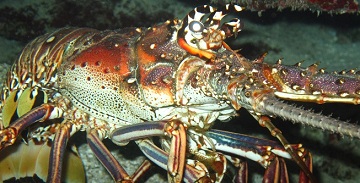 Lobsters use pheremones in their urine to help find their mates. Credit: National Oceanic and Atmospheric Administration.
Lobsters use pheremones in their urine to help find their mates. Credit: National Oceanic and Atmospheric Administration.In fact, both male and female lobsters check out the “pheromones” of the other partner before mating. Pheromones are chemical signals released by an animal to create a certain response by another individual of the same species. But lobsters release these pheromones in their urine. It has only been in the past decade or so that researchers have understood how lobsters use their pee for mating.
One long-time misconception, mostly among the public, is that lobsters mate for life. While lifetime monogamy is not the lobster way, these crustaceans are mostly faithful to one female at a time: a male mates with one female for a week or two before inviting in the next one. Another misconception is that the male is more interested in the female’s scent. But it is females who decide to enter a male’s den based on the chemicals he emits.
As a female hovers outside a male’s den, he releases urine from small ducts on the front of his face. She investigates his pheromones to determine if she wants him as her mate. Her choice is doubly important: females want strong offspring, but they also need reliable protection. After all, the female molts her protective shell just before mating, which leaves her naked and vulnerable. A strong male can protect her until her hard covering grows back. Once it does, she moves along, possibly seeking another partner, while the male again releases urine to attract his next mate.


